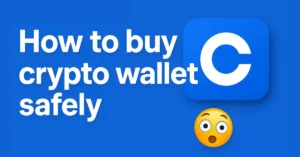Avoid crypto scams:
Introduction
Cryptocurrency has become one of the most talked-about topics in the digital world. From Bitcoin to new tokens launching every day, more and more people are showing interest in investing and trading crypto. While this growing popularity has opened up many opportunities, it has also attracted scammers looking to take advantage of newcomers and even experienced investors.
Crypto scams are becoming a major issue in the online world. These scams can lead to big financial losses and are often hard to trace. That’s why it’s so important to understand what these scams are, how they work, and—most importantly—how you can avoid them.
In this blog, we’ll break down the most common types of crypto scams, warning signs to look out for, and practical tips to keep your money and personal information safe. Whether you’re just getting started or already investing in crypto, this guide will help you stay alert and protect yourself in the crypto space.
Common Types of Crypto Scams
As the crypto market grows, so do the tricks used by scammers. Understanding the most common types of crypto scams can help you stay safe. Here are some scams you should know about:
Phishing Scams
- Phishing scams usually come in the form of fake emails, websites, or messages that look official. Scammers try to trick you into giving away your private keys, passwords, or wallet information. Once they get access, they can steal your crypto instantly.
Fake Giveaways or Airdrops
- Scammers often promise free crypto in return for a small “verification” payment or personal details. They may claim to be a big company or a famous person. But once you send them money or information, you get nothing in return—and your funds are gone.
Ponzi and Pyramid Schemes
- These scams promise high returns if you invest and get others to do the same. Early investors may earn something, but the system collapses when new money stops coming in. Eventually, most people lose their investment.
Fake Exchanges or Wallets
- Some websites or apps pretend to be real crypto exchanges or wallets. They may even work for a short time, but once you deposit your crypto, it disappears. Always double-check the source before using any platform.
Rug Pulls in DeFi Projects
- In the decentralized finance (DeFi) space, developers may launch a new token, attract investors, and then suddenly withdraw all the funds and vanish. This is called a “rug pull,” and it’s more common than people think, especially with new or unknown projects.
Social Media Impersonation
- Scammers create fake profiles of popular crypto influencers or companies. They reach out to followers, promising investment deals, giveaways, or help. Always verify accounts before trusting any information shared on social platforms.
How to Spot a Crypto Scam
Spotting a crypto scam isn’t always easy—scammers are smart and know how to make their traps look real. But there are certain warning signs you can watch out for. If you notice any of these red flags, it’s a good idea to stay away.
Promises of Guaranteed Profits
- If someone says you’ll make huge profits quickly and with zero risk, it’s likely a scam. In crypto, just like in any investment, there are no guaranteed returns.
Pressure to Act Fast
- Scammers often try to rush you. They might say a special offer is “about to end” or that you need to “invest now” before it’s too late. This is a trick to stop you from thinking clearly.
No Clear Information
- Legit crypto projects are transparent. They’ll have a website, a whitepaper, a clear team, and contact details. If the project looks vague, has no real information, or avoids questions—be careful.
Fake or Suspicious Links
- Check links closely. Scammers may create websites that look almost identical to real ones but with a small spelling change in the URL. These sites are designed to steal your login or wallet details.
Asking for Your Private Key
- No real crypto platform or person will ever ask for your private key or seed phrase. If someone does, it’s 100% a scam.
Unrealistic Testimonials or Reviews
- Be cautious of reviews or comments that sound too perfect. Scammers often use fake testimonials or bots to make their offer look legit. Look for balanced, honest reviews from multiple sources.
Unverified or Anonymous Team
- If a project’s team members are hard to find or have no history online, it’s risky. Trustworthy teams are open about who they are and what they’ve done before.
Red Flags to Watch For
Knowing the red flags of a crypto scam can save you from losing money. Scammers often follow patterns, and once you learn what to look out for, it becomes easier to avoid their traps. Here are some common warning signs:
Guaranteed Returns
- If someone promises that you will earn a fixed amount of profit (like “double your money in 7 days”), that’s a major warning sign. No one can guarantee profits in the crypto market.
Requests for Private Keys or Seed Phrases
- Your private key or seed phrase gives full access to your wallet. No real company or person will ever need this. If someone asks for it, it’s a scam—100% of the time.
Anonymous or Fake Team Members
- Trustworthy crypto projects are built by real people with real profiles. If the team is anonymous, has no online presence, or their photos and bios seem copied or fake, be very cautious.
No Clear Roadmap or Whitepaper
- Serious crypto projects usually share a clear roadmap (plan for development) and a whitepaper (explaining how the project works). If there’s no solid information, it could be a scam.
Aggressive Marketing with No Substance
- If you see a project being pushed all over social media with flashy language but no real details or working product, it’s likely hype-driven and risky.
Poorly Designed Websites or Broken Links
- Scam websites often look unprofessional. They may have grammar mistakes, missing pages, broken links, or a very basic layout. These are signs of a quick scam setup.
Unregulated Platforms
- If a trading platform or wallet is not registered or doesn’t follow any legal rules, it’s harder to trust. Stick to well-known, regulated platforms when dealing with money.
How to Protect Yourself
Staying safe in the crypto world isn’t just about being lucky—it’s about being smart and careful. Here are some easy and practical tips to help you protect yourself from crypto scams:
Do Your Own Research (DYOR)
- Before investing in any crypto project, always do your own research. Look into the project’s website, whitepaper, team, reviews, and roadmap. Don’t rely only on what you hear from others or on social media.
Use Trusted Platforms
- Stick to well-known and reliable exchanges and wallets. Avoid using random apps or websites that you’ve never heard of, even if they promise better returns or low fees.
Enable Two-Factor Authentication (2FA)
- Always turn on 2FA for your crypto accounts. This adds an extra layer of security and makes it harder for someone to hack into your account.
Never Share Your Private Key or Seed Phrase
- Treat your private key like your bank PIN—keep it secret and offline. No one needs this info except you. If someone asks for it, it’s a scam.
Be Careful with Links and Emails
- Don’t click on suspicious links or open emails from unknown senders. Scammers often send fake emails pretending to be from real crypto companies. Always check the sender and URL carefully.
Keep Your Software Updated
- Make sure your crypto apps, wallet software, and devices are always up to date. Updates often include important security fixes.
Follow Official Channels Only
- Always follow official pages of crypto projects (check their verified websites or links). Don’t trust random Telegram groups, Twitter accounts, or WhatsApp messages claiming to represent a project.
What to Do If You’ve Been Scammed
Getting scammed can feel frustrating and even embarrassing, but you’re not alone—it happens to many people. What matters most is how quickly you act. Here are the steps you should take if you’ve been caught in a crypto scam:
Stop All Contact
- If you realize someone is scamming you, stop all communication immediately. Don’t send more money or share any more information.
Gather Evidence
- Take screenshots of messages, websites, emails, wallet transactions, and any other details related to the scam. This can be helpful when reporting the incident or trying to recover your funds.
Report to Authorities
- File a report with your local cybercrime unit or law enforcement agency. Many countries have online portals for reporting internet fraud.
Notify Crypto Platforms
- If you used a crypto exchange or wallet in the scam, contact their support team. While they may not always be able to recover your funds, they can block the scammer’s address and warn other users.
Inform Your Bank
- If you gave out credit card or bank details, contact your bank right away. They might be able to block unauthorized transactions or secure your account.
Warn Others
- Sharing your experience can help protect others. Leave reviews, comment on forums, or post warnings on social media to alert the community.
Be Careful Going Forward
- Use the experience as a lesson to stay alert. Scammers often change their tactics, so keep learning and be cautious before trusting anyone with your money.
Frequently Asked Questions (FAQs)
What is a crypto scam?
A crypto scam is a trick used to steal your money, crypto, or personal information. Scammers often pretend to be real companies, projects, or people to gain your trust.
How do I know if a crypto project is real or fake?
Check the project’s website, whitepaper, and team details. Look for reviews, social media activity, and whether they’re listed on trusted crypto platforms. If anything looks suspicious or hard to verify, be careful.
Is it safe to invest in new cryptocurrencies?
Not always. Many new tokens are legit, but some are scams. Always do your own research (DYOR) before investing in anything new or unknown.
What should I do if someone offers me free crypto?
Be cautious. Most “free crypto” offers are scams. Scammers may ask you to send money first or give them personal info. If it sounds too good to be true, it probably is.
Can I get my money back if I’ve been scammed?
In most cases, crypto transactions are not reversible. However, you should still report the scam to authorities, your crypto exchange, and your bank. They might be able to help or stop the scammer.
What are some signs of a fake crypto exchange or wallet?
Fake platforms often have spelling mistakes, no clear company info, unrealistic offers, or poor website design. They may also ask for private keys or seed phrases, which real platforms never do.
How can I stay safe while using crypto?
Use strong passwords, enable two-factor authentication, keep your private key safe, and avoid clicking on suspicious links. Stick to trusted platforms and stay updated on new scams.
Are giveaways on social media real?
Most are fake. Scammers use fake profiles of celebrities or companies to promote giveaways. Always check the official account or website before believing such offers.
Conclusion
Crypto offers exciting opportunities, but it also comes with risks—especially scams. By staying alert, doing your research, and following basic safety tips, you can protect yourself and your money. Remember, if something sounds too good to be true, it probably is. Stay smart, stay safe, and enjoy your crypto journey with confidence.
Bonus Tips: Smart Ways to Save and Stay Safe in Crypto
Use a Hardware Wallet for Long-Term Savings
- For large amounts of crypto or long-term holding, use a hardware wallet (cold wallet). It keeps your crypto offline and safe from online hackers.
Avoid Investing More Than You Can Afford to Lose
- Crypto is risky. Never invest money you need for essentials like rent, bills, or food. Invest wisely and only what you can afford to lose.
Set Strong, Unique Passwords
- Use a different password for each crypto platform. Combine letters, numbers, and symbols. Consider using a password manager for extra security.
Enable Email & Login Alerts
- Turn on email or SMS alerts for logins and transactions. This way, you’ll know right away if someone tries to access your account.
Keep Backups of Wallet Info
- Write down your seed phrase and store it in a safe offline place. Never save it in your phone, email, or online storage.
Double-Check Before Every Transaction
- Always recheck the wallet address and amount before sending crypto. One small mistake can send your funds to the wrong place—with no way to get them back.
Stay Updated on New Scams
- Follow crypto news or reliable blogs to stay informed about new scam methods. Scammers are always finding new tricks—don’t fall behind.
Also read
- What is a Crypto Wallet and How Does It Work? – Coinsify
- 10 Crypto Terms Every Beginner Must Know – Coinsify
- What is Blockchain Technology – Complete Guide – Coinsify
- How to Buy Crypto Safely in 2025 – Complete Guide – Coinsify
- Bitcoin vs Ethereum: Key Differences Explained – Complete Guide
- Ultimate Blockchain Glossary: Learn Blockchain Terms Easily
- How to Buy Bitcoin Safely (Complete Beginner’s Guide)
- Top 10 Crypto Wallets for Beginners (2025 Edition)
- What is Cryptocurrency? A Beginner-Friendly Guide (2025)






